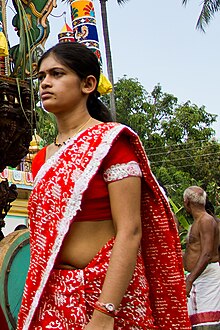
చీర వల్ల కూడా క్యాన్సర్ వస్తుందట.
ఈడ చదువుకోండి
Saree cancer
From Wikipedia, the free encyclopedia
Saree cancer is a type of
skin cancer that occurs along the
waistline in females wearing the
saree,
caused by constant irritation which can result in scaling and changes
in pigmentation of the skin. It is a rare type of cancer and generally
found in the
Indian subcontinent, where the saree is a lifetime female costume.
[1] It is similar to
Marjolin's ulcer in etiology, involving
chronic inflammation.
Etiology
Saree tightened around the waist. A man wearing a
dhoti is seen in the background.
The
Saree
is common female attire in the Indian subcontinent. It is a piece of
long (generally 5.5 metres (18 ft)) cloth which can be made of various
materials:
cotton,
silk,
nylon,
chiffon or
synthetic fabric.
It is worn over an inner skirt (petticoat) which is tightened around
the waist by a thick cotton cord. This is the traditional costume of
most Indian women. The saree is attached to the waist throughout the day
in the hot and humid climate. The waist is often soiled with dust and
sweat and remains without proper cleaning. This causes changes in
pigmentation and mild scaling over the waist. This, in turn, causes
chronic irritation and gradually
malignancy may develop in the skin at the waistline.
[2][3][4]
Signs and symptoms
The foremost symptoms of saree cancer is the constant irritation with
scaling and pigmentation change at the waistline; gradually these
become chronic. The person may have non-healing
ulcer or a hyper- or hypopigmented patch or a growth-like lesion over the waistline. The lesion may be associated with
serous discharge with foul smell.
[2][3]
Management
Excision biopsy is required to confirm the diagnosis of saree cancer. In many cases local excision with
skin grafting is considered the appropriate treatment.
[2][3][1] Different ways of wearing the petticoat may help saree-wearers to prevent saree cancer. Some such strategies are:
- loosening the petticoat
- Changing the usual rope-like belt to broader ones that reduce pressure on the area
- continually changing the level at which the petticoat is tied[1]
History of the disease

Women commonly wear the saree for their entire lifetime
In 1945 physicians Khanolkar and Suryabai described a new type of
skin cancer with hypopigmented and thickened scars which were more
likely to progress into malignant lesions. They termed it "dhoti
cancer", the
dhoti
being a traditional male costume of India which like the saree is
wrapped around the waist. The term "saree cancer" was first used by a
group of doctors led by Dr. A.S. Ptil from Bombay Hospital, India, in
the
Bombay Hospital Journal. The dermatological problem in the
waist of Indian women wearing sarees had been recognised before by some
other researchers. This type of cancer is now related to
Marjolin's ulcer, the malignant degeneration of a chronic wound which was described by
Jean-Nicolas Marjolin in 1828.
[2][3]
References


అయితే పోను పోను చీరలు కట్టుకునేవారు కరువైపోతారన్నమాట!
ReplyDelete